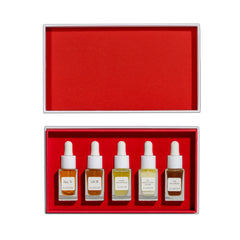The current project I am working on in OUMERE Labs is to survey the changes in skin at the cellular level. The experiment I am conducting now is to compare skin that has been undergoing daily liquid exfoliation with the No. 9 exfoliant, and to compare it to skin that is untreated.
I believe that after one week, there will be visible differences to the skin from the experimental group that will highlight the benefits of exfoliating the skin every day with the No. 9.
The current experiment is on day 5 of 7, and on the 7th day I will begin the histological techniques needed to then view the specimens under the scope and get my final results.
This first round of the experiment is mostly for me to fine tune my embedding techniques because a lot needs to be figured out first before going into a large scale run of the study. Once I am able to use these current specimens to hone in on exactly how to carry on the embedding, fixation, staining and other histological techniques I can repeat the experiment with a large sample size.
Below is an overview of the study that will be conducted in OUMERE Labs for the next few months:
Materials & Methods
Human skin samples obtained from live human tissue will be used for this study. The samples are obtained from Genoskin, who retrieves donated skin from human patients.
Current sample profile:
Sex: F
Age: 45 years old
Origin: Hispanic
Skin type: 2
BMI: 32.4
Anatomical site: Abdomen
Surgery date: 09/07/2022
The skin samples are biopsied into 11mm sections and individually placed into wells in a 12 well plate. Once the well plate is received into the lab, growth medium is added to the plates once per day for 7 days to keep the skin alive.

The specimens are incubated in a CO2 incubator at 37C per the manufacturers recommendations.

Since I am just using this first round to determine my embedding techniques, I am just using one well for the experimental, and one for the control.
Experimental protocol: Every day at 10:00 AM the experimental well is swabbed with a cotton swab containing the No. 9 exfoliant.

Control protocol: Every day at 10:00 AM the control well is swabbed with a cotton swab containing distilled water.

The specimens are then put back into the incubator for 24 hours.
Next steps
Once the experiment is completed on Friday, I am going to follow typical electron microscopy techniques to embed the specimens even though I am not going to look at these specimens under the EM. The reason for using EM techniques is because I believe the fixative and sectioning steps involved will give me a better view of the samples under the light microscope than if I were to use common tissue prep techniques . Such as paraffin embedding and trichome staining along with sectioning under a microtome (as opposed to the ultratome I will be using here).
I think for this sample fixation with picric acid followed with a drawn out dehydration then embedding in epoxy resin will give an interesting look of the tissue samples above, so I am going to give it a try. The tissue prep will take about one week, then I can section the samples, stain it and look at it under the light microscope.
If all of the above goes according to plan, I will then repeat the above experiment with 11 experimental wells, and 1 control.
Predictions:
I predict for this experiment that there will be a visible change in the thickness of the experimental sample. This change will be due to the upregulation of skin extracellular matrix proteins.


